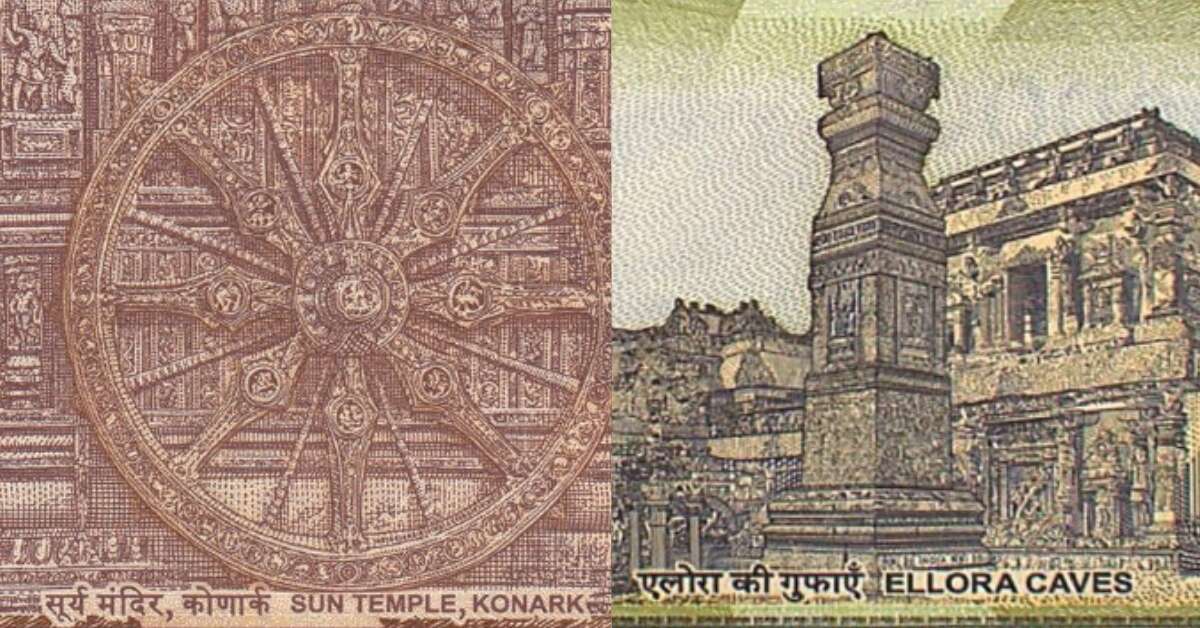

If you’ve ever paused to examine the ten and twenty-rupee notes that pass through your hands daily, you might’ve noticed they’re more than just money. Far beyond their role in everyday transactions, these notes are imprinted with some iconic landmarks of the nation, making them a gallery of India’s heritage! Interesting, right? Let’s take a look at the marvellous monuments splayed out on Indian currency, and perhaps inspire you to add them to your travel list if you haven’t yet visited!
This UNESCO World Heritage Site, built in the 13th century by King Narasimhadeva I, is designed as a massive chariot for the sun god Surya, complete with 24 intricately carved stone wheels and seven horses.
Once used as a sundial due to its precise alignment with the sun, this temple amazes visitors with its detailed sculptures depicting daily life, mythology, and celestial beings.
The INR 10 note, introduced in January 2018, proudly displays this architectural gem.
Located in Maharashtra, this UNESCO-listed site is part of a series of 34 rock-cut caves dating back to the 6th–10th centuries. The Kailash Temple (Cave 16) is the crown jewel. It is a monolithic marvel carved from a single rock, dedicated to Lord Shiva. Spanning over two million cubic feet, it features elaborate carvings of gods, goddesses, and mythical creatures, making it one of the largest single-rock excavations in the world. This note celebrates its awe-inspiring craftsmanship.
Hampi, Karnataka, itself is a sprawling open-air museum, dotted with over 1,600 ruins, including temples, palaces, and bazaars, set against a surreal landscape of boulders and hills. The note captures the essence of this medieval marvel.
Built in the 11th century by Queen Udayamati in memory of her husband, King Bhimdev I, this seven-story underground structure is an architectural wonder. Designed as an inverted temple, it boasts over 500 detailed sculptures of deities, nymphs, and geometric patterns along its stepped corridors. Originally constructed to store water during dry seasons, Rani ki Vav , though made for the purpose of utility, displays some eye-catching artistry. The note beautifully highlights its elegance.
Commissioned by Emperor Ashoka in the 3rd century BCE, this Buddhist monument is renowned for its massive hemispherical dome and intricately carved gateways, or toranas, depicting scenes from the life of Buddha. Located atop a hill, Sanchi is a serene pilgrimage site that reflects India’s deep spiritual heritage. The note immortalizes its timeless significance.
Read also- Take a trip from Visakhapatnam to the past at these 6 ancient lost Indian cities!
Isn’t it fascinating that the mere currency notes we assign value to depict monuments which are all simply invaluable? They’re a display of the architectural splendour of our country and a gentle reminder to explore the monumental greatness of our past. If you’ve got a bucket list, make sure to add these monuments to it and pay them a visit as part of an Indian currency-inspired tour!
Stay tuned to Yo! Vizag website and Instagram for more such articles.
In a progressive move towards integrating emerging technologies into higher education, Andhra University (AU) has…
Life can be unpredictable, like the weather in our city! While the mornings and afternoons…
There are places in the world where spotting your doppelganger isn’t a once-in-a-lifetime event, it’s…
Plans are underway to launch a Vande Bharat Express connecting Vijayawada and Bengaluru. The Indian…
In a significant counter-terrorism operation, Vizianagaram police have arrested two alleged terrorists hailing from Vizianagaram…
The India Meteorological Department (IMD) has forecast continued rains across several regions of Andhra Pradesh…
Leave a Comment